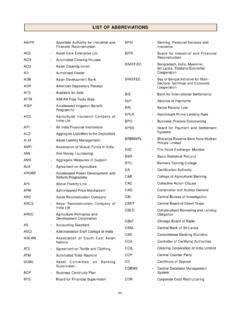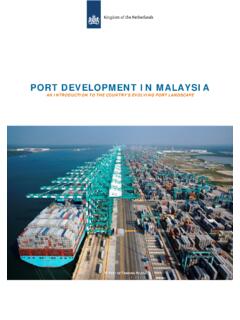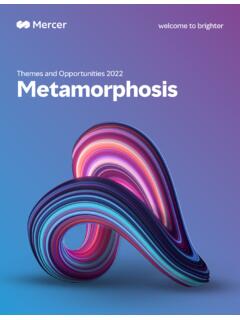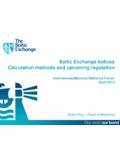Transcription of ADDRESSING ILLEGAL WILDLIFE PHILIPPINES
1 ADDRESSING ILLEGAL WILDLIFE TRADE IN THE PHILIPPINESPHILIPPINESS econd-largest archipelago in the world comprising 7,641 islandsOne of only 17 mega-diverse countries for harboring WILDLIFE species found nowhere else in the world240 Protected Areas 228 Key Biodiversity Areas More than 52,177 described species, half of which are endemic5th in the world in terms of total plant species, half of which are endemic342 species of reptiles, 68% are endemic4th most important country in bird endemism with 695 species (195 endemic and 126 restricted range)114species ofamphibiansHome to 5 of 7 knownmarine turtle speciesin the world green, hawksbill, olive ridley, loggerhead, andleatherback turtlesCurrent population is 100 million, but projected to reach 125 million by 2030; most people, particularly the poor, depend on biodiversityThe PHILIPPINES is a consumer, source, and transit point for IWT, threatening endemic species populations, economic development, and biodiversity.
2 The country has been a party to the Convention on Biological Diversity since 1992. The value of IWT in the PHILIPPINES is estimated at 50 billion a year (roughly equivalent to $1billion), which includes the market value of WILDLIFE and its resources, their ecological role and value, damage to habitats incurred during poaching, and loss in potential ecotourism value of ILLEGAL WILDLIFE Trade (IWT) is estimated at $10 billion $23 billion per year, making WILDLIFE crime the fourth most lucrative ILLEGAL business after narcotics, human trafficking, and CONFISCATIONS AND SEIZURES 2,870 pangolins (2013) 354 marine turtles (2014) 4,300 freshwater turtles, 4,000 of which were Philippine forest turtles (2015) 58 pangolins (2017) 70 hawksbill turtles (2017)
3 58 Goffins cockatoos (2017) nearly 1,000 endemic pitcher plants and lady slipper orchids (2017) 106 sulfur-crested cockatoos (2018) 462 Indonesian endemic parrots over at least 4 seizures (2013 2017) 5 tons of elephant ivory tusks (1996 2009) 1,522 mynas (2000 2006) 652 blue-naped parrots (2000 2006) 95 kg of pangolin scales and 36 kg of pangolin meat equivalent to approximately 200 individual pangolins (2012) ILLEGAL WILDLIFE TRADENote: kg = kilogram, = Philippine peso, $ = United States : Confiscation records from the Department of Natural Resources Biodiversity Management Bureau (DENR BMB) and the Palawan Council for Sustainable Development (PCSD) of the WILDLIFE PROGRAMR ecognizing the threats of the ILLEGAL WILDLIFE trade (IWT) to the country s biodiversity and economy, the Philippine government passed legislation, created inter-agency groups to combat the trade in ILLEGAL WILDLIFE and WILDLIFE parts, and is building capacity across the law enforcement chain.
4 The 10-year national WILDLIFE Law Enforcement Action Plan (WildLEAP) 2018-2028, which is aligned with the Philippine Biodiversity Strategy and Action Plan, serves as the national road map to address WILDLIFE crimes and a guide to prioritizing enforcement activities, allocating funds and resources, and evaluating impacts of the collaboration of key law enforcement agencies, national, regional, provincial and local government bodies, and civil society organizations, WildLEAP will focus on stronger policies, networking and coordination, building capacity, communication, education and public awareness, improving governance and curbing Environmental Organized Crime in the PhilippinesAddressing WILDLIFE crime in the PHILIPPINES through legal and institutional reforms, building capacity throughout the full enforcement chain, and reducing demand for ILLEGAL WILDLIFE and WILDLIFE Implementing AgencyDepartment of Environment and Natural Resources-Biodiversity Management Bureau (DENR-BMB)Financing Global Environment Facility (GEF): US$ million Government of the PHILIPPINES (DENR): US$575,757 Executing AgencyAsian Development BankPROJECT SITES: ButuanMetro CebuMetro ManilaInternational PartnersThe International Consortium on Combating WILDLIFE Crime.
5 CITES Secretariat, INTERPOL, the United Nations Office on Drugs and Crime, the World Bank, and the World Customs Photo: Last of the Dying Breed from the book Haring Ibon: The Great Philippine Eagle by Alain Pascua. Special thanks to Alain Pascua, the Palawan Council for Sustainable Development, AA Yaptinchay, Miguel Lorenzo Mamon, Emerson Y. Sy, Erickson Tabayag, and Francesco Ricciardi for by Ross Locsin COMPONENTSO utcomesEconomic valuation studies and research on consumer buying behaviour. Behaviour change communication strategy and large-scale public awareness campaign engaging key opinion leaders, influencers, and youthOutputs134 Strengthened legal frameworksIncreased sharing of information and knowledgeLong-term capacity building programDemand reduction measures implemented References: The Biodiversity Finance Initiative (BIOFIN) UNDP 2017.
6 Compilation of Reports 2014-2017 Quezon City Canlas, Sy, and S. Ching 2017. Rapid Survey of online trade in live birds and reptiles in the PHILIPPINES . TRAFFIC Bulletin Government of the PHILIPPINES . DENR-BMB 2016. Philippine Biodiversity Strategy and Action Plan 2015-2028. Manila L. Gomez and Sy 2018. ILLEGAL Pangolin Trade in the PHILIPPINES . TRAFFIC Bulletin 2018 Sy 2018. Trading Faces: Utilisation of Facebook to Trade Live Reptiles in the PHILIPPINES TRAFFIC, Selangor, Malaysia 134 Reforming and mainstreaming policy, legal and regulatory instrumentsAssessing and ADDRESSING capacity and resource gaps across the entire law enforcement chainTraining and roll-out.
7 Port monitoring and tracking systems, CITES e-permitting system (E-Cites), intelligence gathering and case buildingConservation status- DENR Administrative Order 2004-15 (DAO-2004-15) - Convention on International Trade in Endangered Species of Wild Fauna and Flora Appendices I and II (CITES)ILLEGALLY TRADED SPECIES IN THE PHILIPPINESC ritically endangeredFacing an extremely high risk of extinction in the wild in the immediate future CROther threatened speciesUnder threat from adverse factors such as overcollection throughout its range. Likely to move to vulnerable in near futureOTSE ndangeredSurvival in the wild unlikely if the causal factors continueENVulnerableUnder threat from adverse factors throughout its range.
8 Likely to be endangered in the futureVUNLNot Listed Endemicnaturally occurring and found only in the country or within a specific area in the country Indigenousnatural population is established in, but not confined to, the country; natural population is also found in other countries Migratoryseasonal visitor to the country Philippine forest turtle (Siebenrockiella leytensis) Palawan Semi-aquatic turtle Very high demand and value Poached to supply the national and international black markets for pets and foodSoutheast Asian box turtle (Cuora amboinensis) Throughout the PHILIPPINES and SEAsia Most commonly traded native turtle species and is particularly threatened by ILLEGAL and unsustainable collecting.
9 Novice and impulse buyers are the main consumersHawksbill turtle (Eretmochelys imbricata) The PHILIPPINES , Atlantic, Pacific and Indian oceans and worldwide Shells are primary source of tortoiseshell used for ornaments and jewelryAsian leaf turtle (Cyclemys dentata) Balabac, Palawan, Siasi, Tawi-Tawi Illegally collected in Palawan and transported and traded in Metro ManilaMost traded speciesPalawan pangolin (Manis culionensis) Palawan faunal region Critically Endangered through the issuance of PCSD Resolution No. 15-521. No trade or hunting of the species is allowed, not even by indigenous groups. Listed in CITES appendix I In high demand for meat as a luxury food and scales for traditional medicine, particularly in Metro Manila.
10 Wild populations believed to have declined more than 50% over the last 21 yearsBlue-naped parrot (Tanygnathus lucionensis) Near endemic Can be found in many islands in the PHILIPPINES but numerous in some areas of Palawan and Tawi-tawi. It can also be found in the Talaud Islands, Indonesia, and islands off north-east Borneo belonging to MalaysiaTokay Gecko (Gekko gecko) Throughout the PHILIPPINES , SEAsia, and South Asia Suffered from frenzy of over collection because of rumor that they cure HIV/AIDS and could be sold for thousands of pesosPalawan hill mynah (Gracula religiosa palawanensis) Palawan Hill Mynah Philippine Talking Mynah or Palawan Mynah Palawan: Balabac, Busuanga, Culion, Sulu, Tawi-Tawi Poached from forests for local pet tradeAlso Traded and/or ThreatenedGiant golden-crowned flying fox (Acerodon jubatus) PHILIPPINES except Palawan faunal region, Batanes and Babuyan groups Facing possibe extinction because of poaching and forest destructionPhilippine slow loris (Nycticebus menagensis) Borneo and PHILIPPINES (Sulu Archipelago) Trading localized to Mindanao, and Malaysia, but sold in streetsMindanao water monitor (Varanus cumingi), Luzon or marbled water monitor (Varanus marmoratus)















